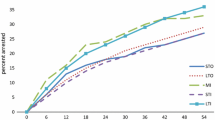Abstract
The current study examined the criminal justice experiences of foster care youth living with relatives, foster families, and living in congregate care; dependents receiving in-home care; and non-dependent youth. Specific attention was directed at uncovering whether form of maltreatment, placement type, and/or placement instability were related to delinquency. A prospective analysis of official record data followed children in Los Angeles County from the time of a first admission to the Department of Children and Family Services (DCFS) to potential involvement in the criminal justice system (N = 1,235). The study also utilized a matched control design in which DCFS cases were compared to non-dependent controls (N = 1,235). The most consistent predictors of delinquency were placement instability and age at placement. Youth who were older at placement and youth with at least one placement change were more likely to be arrested for violent and non-violent crimes as well as be charged by the district attorney than younger youth with no placement changes.
Similar content being viewed by others
References
Baskin D, Sommers I (1998) Casualties of community disorder: women’s careers in violent crime. Westview, Boulder
Child Welfare League of America (2005) Residential group care. Retrieved May 1, 2009, from http://www.cwla.org/programs.groupcare.groupcareaboutpage.htm
Cicchetti D, Barnett D (1991) Attachment organization in preschool aged maltreated children. Dev Psychopathol 3:397–411
Cicchetti D, Ganiban J, Barnett D (1991) Contributions from the study of high-risk populations to understanding the development of emotion regulation. In: Gerber J, Dodge K (eds) The development of emotion regulation and dysregulation. Guilford, New York, pp 15–48
Cicchetti D, Rogosch F, Maughan A, Toth S, Bruce J (2003) False belief understanding in maltreated children. Dev Psychopathol 15:1067–1097
Cusik G, Courtney M (2007) Offending during adolescence: How do youth aging out out of care compare with their peers? Issues Brief #111, Chapin Hall
Department of Child and Family Services (2009) Definitions. Retrieved, December 7, 2009, http://dcfs.co.la.ca.us/aboutus/defsglossary/dcfs_glossary_all.htm
Egeland E, Sroufe L, Erickson M (1983) Developmental consequences of different patterns of maltreatment. Child Abuse Negl 7:459–469
Egeland B, Yates T, Appleyard K, van Dulmen M (2002) The long-term consequences of maltreatment in the early years: a developmental pathway model to antisocial behavior. Children’s Serv Soc Policy Res Pract 5:249–260
English D, Widom C, Branford C (2002) Childhood victimization and delinquency, adult criminality, and violent criminal behavior: A replication and extension. National Institute of Justice, Washington, D.C
Farrington D (2005) Childhood origins of antisocial behavior. Clin Psychol Psychother 12:177–190
Fein E, Malucci A, Kluger M (1990) No more partings: an examination of long-term foster family care. Child Welfare League of America, Washington, D.C
Grisso T (2002) Using what we know about child maltreatment and delinquency. Children’s Serv Soc Policy Res Pract 5:299–305
Hansen B (2004) Full matching in an observational study of coaching for the SAT. J Am Stat Assoc 99:609–618
Johnson-Reid M (2002) Exploring the relationship between child welfare intervention and juvenile corrections involvement. Am J Orthopsychiatry 72:559–576
Johnson-Reid M, Barth R (2000) From maltreatment report to juvenile incarceration: the role of child welfare services. Child Abuse Negl 24:505–520
Johnson-Reid M, Barth R (2003) Probation foster care as an outcome for children exiting child welfare foster care. Soc Work 48:348–361
Lee V, Hoaken P (2007) Cognition, emotion, and neurobiological development: mediating the relation between maltreatment and aggression. Child Maltreat 12:281–298
Leitenberg H, Burchard J, Healy D, Fuller E (1981) Nondelinquent children in state custody: does type of placement matter? Am J Community Psychol 9:347–360
Lyons-Ruth K, Jacobvitz J (1999) Attachment disorganization: unresolved loss, relational violence, and lapses in behavioral and attentional strategies. In: Cassidy J, Shaver PR (eds) Handbook of attachment: theory, research, and clinical applications. Guilford, New York, pp 520–556
Maxfield M, Widom C (1996) The cycle of violence revisited six years later. Arch Pediatr Adolesc Med 150:390–395
Morris L (1994) Youth in foster care who commit delinquent acts. Child Welfare League America. Retrieved May 1, 2009, http://www.cwla.org
Parrott D, Giancola P (2004) A further examination of the relation between trait anger and alcohol-related aggression: the role of anger control. Alcohol Clin Exp Res 28:855–864
Pew Commission on Children in Foster Care (2004) Fostering the future: safety, permanence, and well-being for children in foster care. Retrieved May 1, 2009, http://www.pewfostercare.org
Preski S, Shelton D (2001) The role of contextual, child, and parent factors in predicting criminal outcomes in adolescence. Issues Ment Health Nurs 22:197–205
Runyan D, Gould C (1985) Foster care for child maltreatment: impact on delinquent behavior. Pediatrics 7:562–568
Ryan J, Testa M (2005) Child maltreatment and juvenile delinquency: investigating the role of placement and placement instability. Child Youth Serv Rev 27:227–249
Ryan J, Marshall J, Herz D, Hernandez P (2008) Juvenile delinquency in child welfare: investigating group home effects. Child Youth Serv Rev 30:1088–1099
Smith C, Thornberry T (1995) The relationship between child maltreatment and adolescent involvement in delinquency. Criminology 33:451–481
Tuell J, Widom C, Wigg J (2002) Understanding child maltreatment and juvenile delinquency: from research to effective program, practice and systemic solutions. Child Welfare League of America Press
United States Department of Health and Human Services (2005) Child welfare outcomes 2002–2005: Report to Congress. Retrieved on May 1, 2009, http://www.acf.hhs/programs/cb/pubs/cwo05/chapters/chapter1.htm
Widom C (1989) The cycle of violence. Science 244:160–166
Widom C (1991) The role of placement experiences in mediating the criminal consequences of early childhood. Am J Orthopsychiatry 61:195–209
Zingraff M, Leiter J, Myers K, Johnson M (1993) Child maltreatment and youthful problem behavior. Criminology 31:173–202
Author information
Authors and Affiliations
Corresponding author
Rights and permissions
About this article
Cite this article
Baskin, D.R., Sommers, I. Child Maltreatment, Placement Strategies, and Delinquency. Am J Crim Just 36, 106–119 (2011). https://doi.org/10.1007/s12103-010-9088-9
Received:
Accepted:
Published:
Issue Date:
DOI: https://doi.org/10.1007/s12103-010-9088-9



